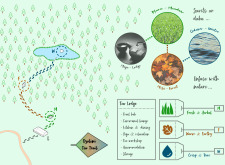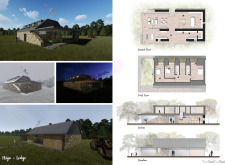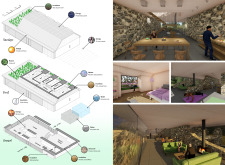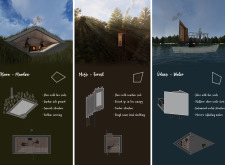5 key facts about this project
Functionally, the Mâja Lodge serves multiple purposes. It acts as a retreat for visitors seeking tranquility and a deeper engagement with nature. The lodge is designed to accommodate a range of activities, including communal dining experiences, workshops on tea brewing, and spaces for yoga and meditation. By integrating these diverse functions within a singular architectural framework, the project promotes a sense of community among guests, encouraging them to connect not only with each other but with the environment around them.
Key components of the architectural design include a spacious lounge area that fosters social interaction among guests, a well-equipped kitchen designed to facilitate communal dining, and private rooms that offer a peaceful escape. The interplay between indoor and outdoor spaces is thoughtfully considered, with large windows and glass doors that invite natural light and allow vistas of the surrounding landscape to become an integral part of the experience. The use of natural materials such as stone and wood reinforces the lodge's connection to its environment, while modern design techniques contribute to a sense of comfort and aesthetic appeal.
One of the unique aspects of this design is the incorporation of integrated trails that guide visitors through the natural beauty of the site. These pathways not only lead to various points of interest, such as the meadows and forest areas but also provide opportunities for reflection and immersion in nature. This design approach enhances the visitor experience, as it encourages exploration and promotes a deeper understanding of the ecological context.
Additionally, the architectural choices reflect a commitment to sustainable practices. The lodge features a green roof that serves multiple functions, including natural insulation and the promotion of local biodiversity. The use of energy-efficient systems, such as photovoltaic panels, underscores a forward-thinking approach to energy management, ultimately aiming for reduced environmental impact.
The Mâja Lodge also serves as a cultural landmark, where visitors can partake in workshops that highlight local tea-making traditions. This aspect of the project emphasizes the importance of heritage and community connection, making it a site not just for leisure but for educational engagement as well.
In conclusion, the Mâja Lodge presents an architecture that effectively balances function, aesthetic integrity, and environmental responsibility. It stands as a representation of how thoughtful design can foster community, support sustainability, and create experiences that resonate with both visitors and the natural landscape. For those interested in delving deeper into the architectural concepts and ideas that shape this project, exploring the architectural plans, sections, and designs will provide valuable insights into its thoughtfully crafted details and unique vision.


























